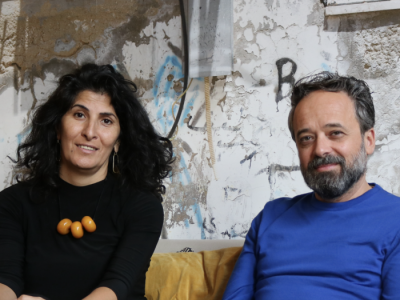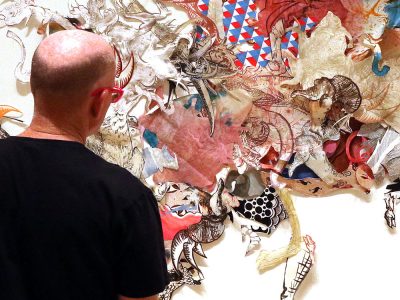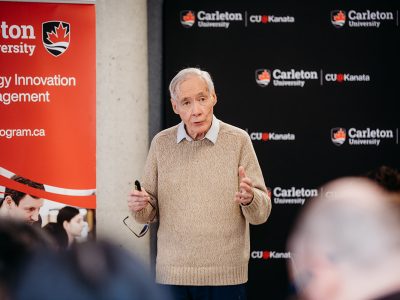By Dan Rubinstein
Photos by Dan Rubinstein
Anchored in an aluminum skiff on a small bay at the eastern edge of Big Rideau Lake, Jordanna Bergman nets a northern pike from a large cooler full of water and live fish and lowers it into a shallow plastic trough at the bow of her boat.
Wearing a pair of electric gloves that emit a low-voltage current, Brenna Gagliardi puts her hands around the nose and tail of the pike, immobilizing the fish.
Bergman makes a short incision in the pike’s belly and inserts a cylindrical two-centimetre-long acoustic transmitter, calling out the tag’s identification number to André Killeen, who is sitting in the stern with a logbook.
With the precision of a brain surgeon, Bergman swiftly sews up the incision with a pair of sutures, attaches a thin plastic external tag near the tail fin with a tagging gun, measures the length of the fish for Killeen to write down, then gently lowers it over the side of the boat, where it swims out of sight in the murky water.
Thanks to a network of 85 acoustic telemetry receivers set up throughout a 60-kilometre-long stretch of the Rideau system, Bergman, a PhD student at Carleton University, will be able to track the movement of that northern pike and 249 other fish — including largemouth bass, common carp and round goby — this summer.
The acoustic transmitters emit pings every 20 seconds; the receivers, which look like tall wine bottles immersed in the water, will register those pings if they’re within 200 metres. Once retrieved in the fall, the receivers will provide a flood of information to analyze, although some will be left under the ice to record fish movement over the winter.
Bergman’s research is part of a larger three-year project to determine the impact of human activities on the health of the Rideau ecosystem and help Parks Canada come up with effective management policies.
“Ideally, we’ll be able to protect ecologically and economically important gamefish and while simultaneously minimizing the spread of invasive species,” she says, explaining that in addition to the acoustic transmitters, up to 10,000 other fish will be externally tagged during the multiyear and multifaceted project.
“To do this, we need to collect preliminary movement information. We have so many questions about fish connectivity in the Rideau Canal. Our receiver downloads and data analysis this winter will be the first step toward improving our understanding of fish movement patterns. Until then, we just need the tagged fish to swim and do what they do.”
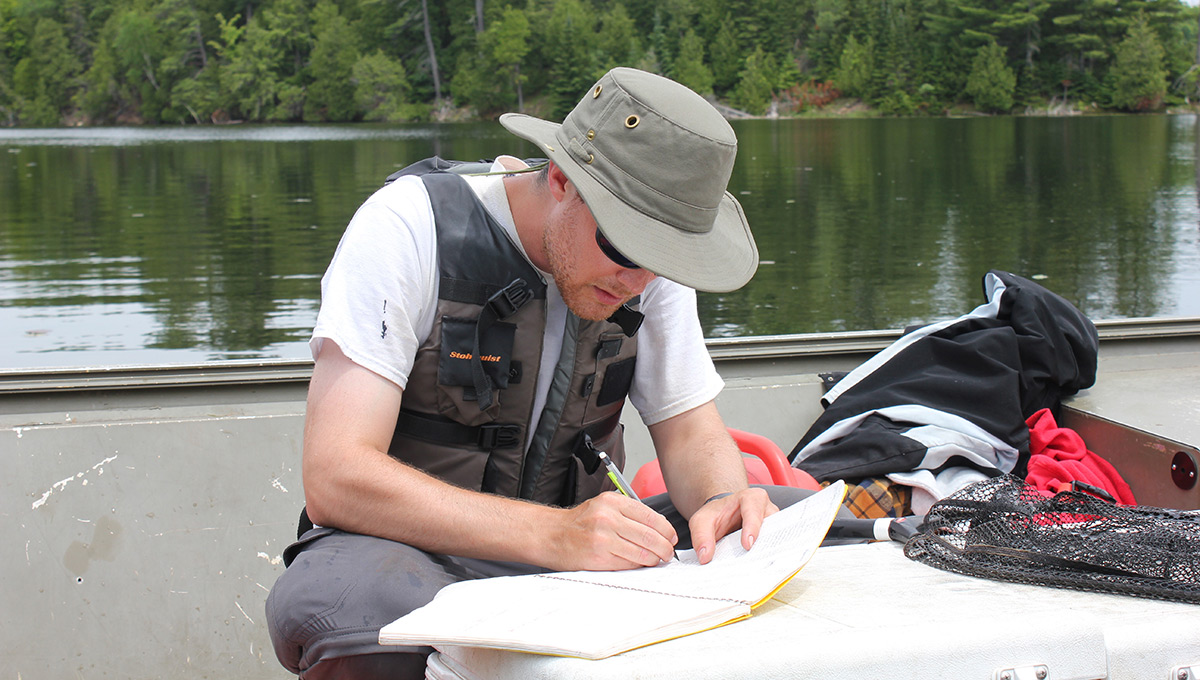
The Deeper Importance of Field Work
On this sunny and warm mid-June day, Bergman and undergraduate Biology students Gagliardi and Killeen are spending about eight hours catching and tagging pike and bass on Big Rideau Lake, an hour and a half southwest of Ottawa.
Bergman’s supervisors — Prof. Steven Cooke, a Canada Research Professor in Environmental Science, and Biology Prof. Joseph Bennett, both investigators on the $650,000 NSERC-funded research project with Parks Canada — are in a second boat with post-doctoral fellow Hsien-Yung Lin, catching more fish to tag.
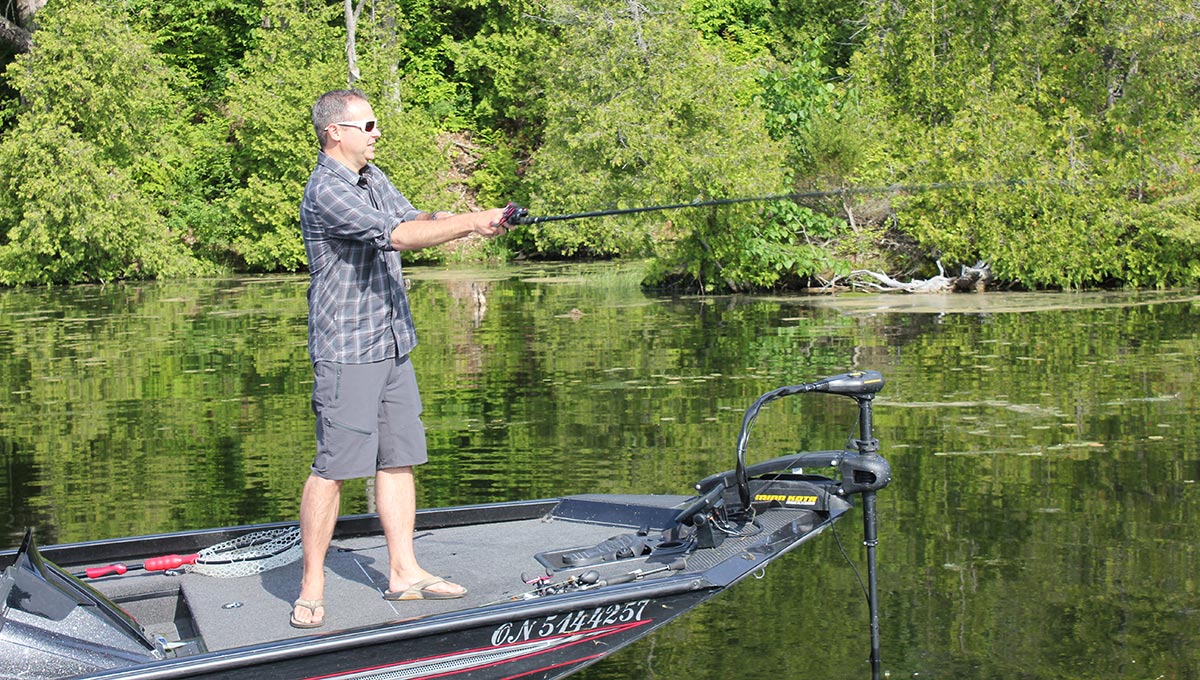
Prof. Steven Cooke casts a line in Big Rideau Lake.
“To do telemetry work, you have to do this part,” says Bergman, who did research on saltwater species in Florida and British Columbia before moving to Ottawa to start her PhD last September. “You have to be in the field. You have to catch and tag fish.
“It’s so much better to be out here on the water, learning about the ecosystem firsthand, than reading about it or listening to somebody talk about it,” she adds. “When you do something hands-on, you form a stronger connection to it. You develop a deeper understanding.”
Bergman’s thesis will focus on fish movement through locks on the Rideau Canal system, which is under increasing pressure from the growing population of cottages and communities — and people who fish — along its banks. We know that fish swim through locks, she says, but we don’t know to what extent, nor whether the movement is seasonal or for reproductive purposes.
We don’t know much about why, when and how fish travel through locks because nobody has studied these questions in this part of the world before. Which is why, with about $1 billion of infrastructure work scheduled for the Rideau over the next 10 years, Cooke sees an opportunity for “conservation gains” that balance environmental and economic priorities.
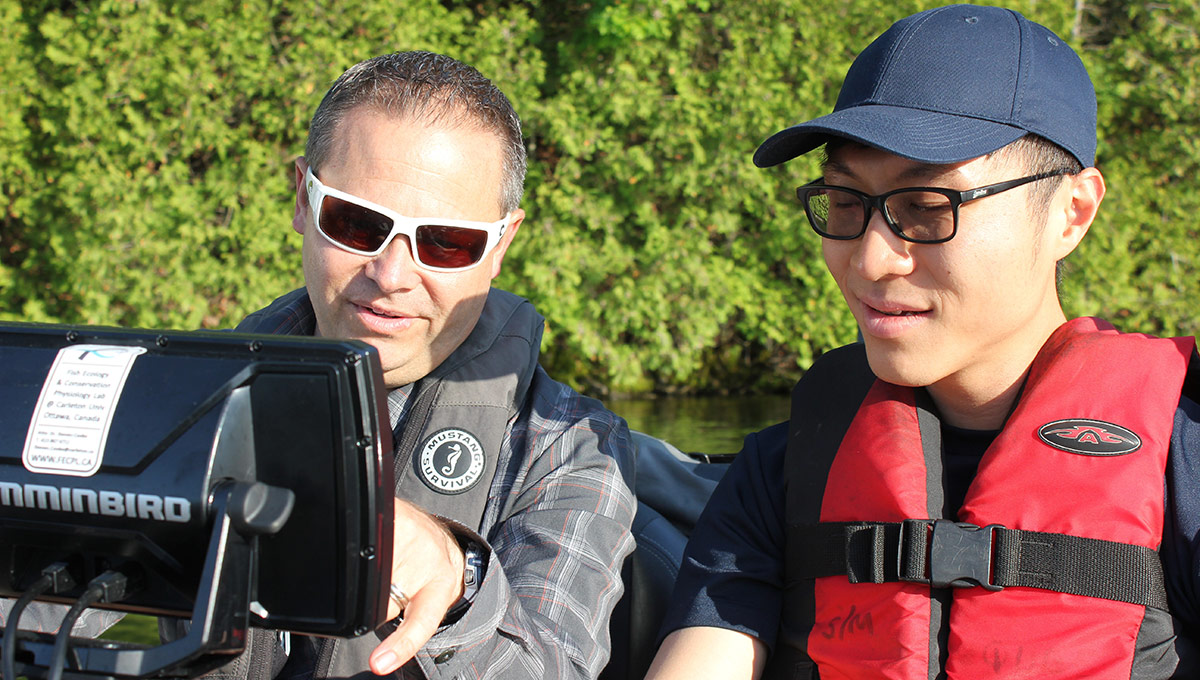
Local Research with International Impact
Northern pike are a particularly mobile species and a prized gamefish, part of a recreational angling industry that generates about $2.2 billion in Ontario every year. Are certain lock structures and operations more conducive to their health? Are there ways to support native fish while limiting the spread of invasive species such as common carp and round goby? And what do local fishers, cottagers and lockmasters think about all this?
These are some of the questions that Cooke, his collaborators and students hope to address. Ultimately, what they discover might not only help safeguard the health of the Rideau system but also provide strategies for managing other waterways throughout the world.
“It takes a lot of time, but this is what you need to do to start to change things,” says Bergman.
“That one fish you tag could help thousands of other fish. I love doing science for the sake of science, but I also want to make a difference and leave the world a little bit better after my short time here.”
Pursuit of this ambitious goal begins with grunt work. With pre-dawn wake-up calls and long days in the rain or wind or sun. With talking to “stakeholders” from diverse walks of life. With learning how to pilot a boat and manage gear in challenging and changing conditions. With figuring out how tiny details relate to the big picture.
All of this gives students an important crash course in juggling multiple responsibilities, and at the same time, instils a powerful bond with the animals and environments that they got into science to understand and protect.
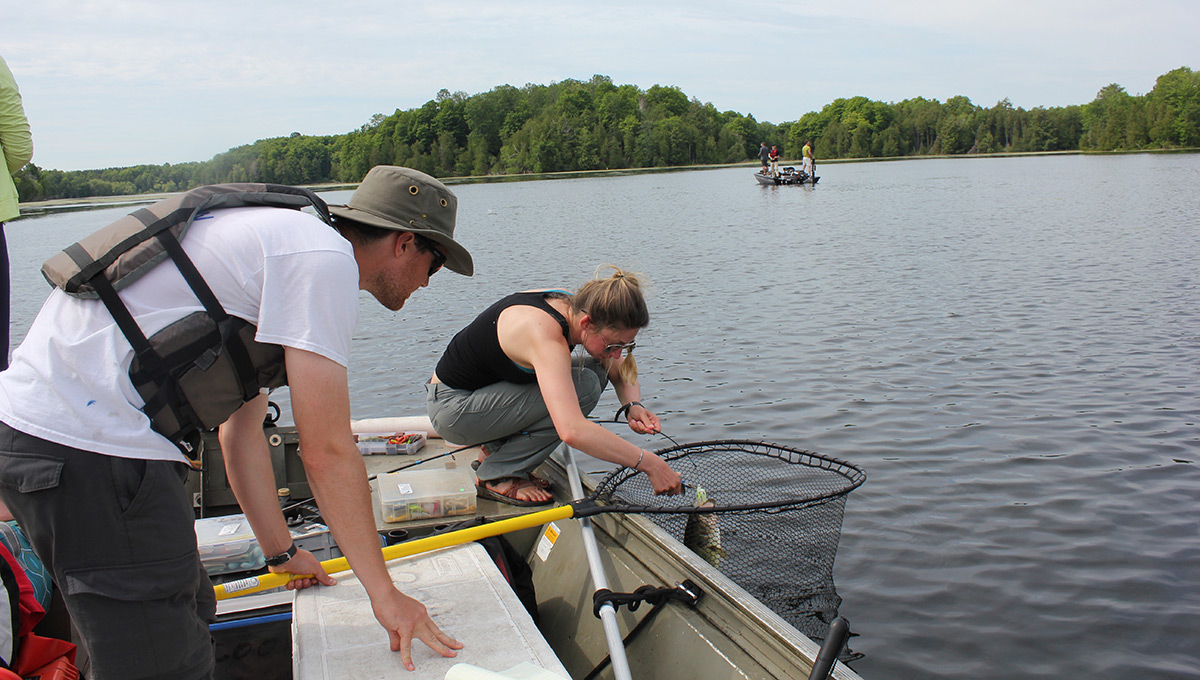
The River that Runs Through Carleton
Cooke, who has been at Carleton for nearly 15 years, is an international leader in fish conservation research. He chairs the Ocean Tracking Network’s science advisory committee, serves as editor-in-chief of the journal Conservation Physiology and travels frequently to present at conferences, including stops in China, Norway and Spain over the past few weeks.
But even though Cooke has a global perspective and is perhaps best known for his work on Pacific salmon, he was on the Rideau as often as possible this past May and June — up to five days a week — to help start the first field season of the project with Parks Canada.
Today, motoring with Bennett and Lin to a three-square-kilometre fish sanctuary on Big Rideau Lake where recreational angling has been prohibited for 80 years, he’s excited about casting for pike and bass on the same waterway that, after it splits into a river and canal at Hog’s Back Falls, surrounds the Carleton campus.
“The Rideau system means a lot to our students,” Cooke says while prepping lures.
“A lot of them skate on it in the winter and kayak on it in the summer. This project is an opportunity to think about its history and ecology and how they connect to the issues we’re dealing with now.
“The canal both fragments and connects. It fragments bodies of water that should be linked, and connects others that shouldn’t. That makes it very interesting to study.
“I think fishing and science are very similar,” he continues. “Fishing is about the unknown. You don’t know what you’re going to get on the end of your line. Science is also about mystery and uncertainty.”
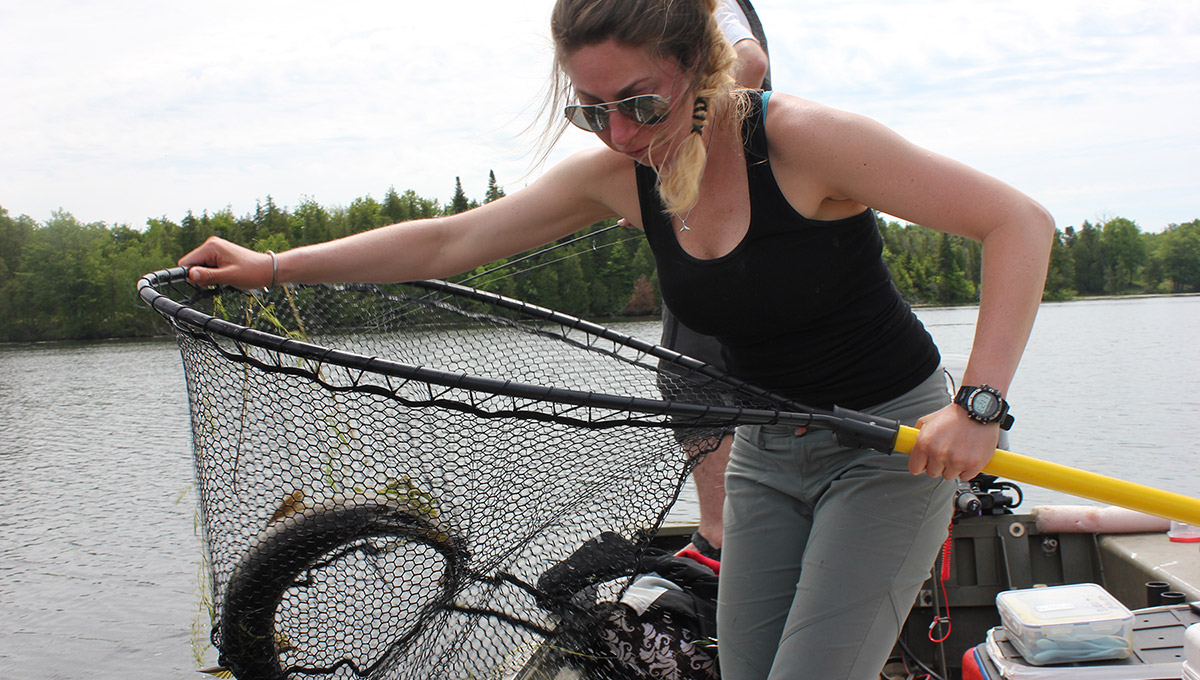
Helping Native Species While Controlling Invasive Species
The project that Cooke and Bennett are part of, along with fellow Carleton faculty member Jesse Vermaire from the Department of Geography and Environmental Studies, four other university professors (including a hydraulic engineering and an environmental sociologist) and two Parks Canada scientists, is investigating both the Rideau and Trent-Severn Waterway, and includes the Big Rideau Lake Association, Rideau Valley Conservation Authority and Muskies Canada as partners.
Beyond looking at fish movement in the two historic waterways, the researchers are also exploring how lock and dam operations could benefit biodiversity, what shoreline erosion management strategies should be adopted, how over-abundant aquatic plants can best be controlled, and how waterway users can contribute to conservation.
Bennett, who was raised on a farm between Smiths Falls and Brockville and grew up fishing on the Rideau, is concentrating on invasive species on the Trent-Severn for his part of the project, including weeds such as Eurasian milfoil and water soldier.
Supervised by both Bennett and Cooke, Lin, a post-doc from Taiwan whose academic career has included stops in Michigan and Australia, is looking at lock and dam structures and invasive species.
“The Rideau and Trent-Severn are very human influenced systems,” says Bennett, “but they also have some rare species. So, the dilemma is how do we operate the system to make the waterways navigable for certain species with minimal impact, while also limiting the spread of invasive species. We need to be creative to take care of native species and block invaders.”
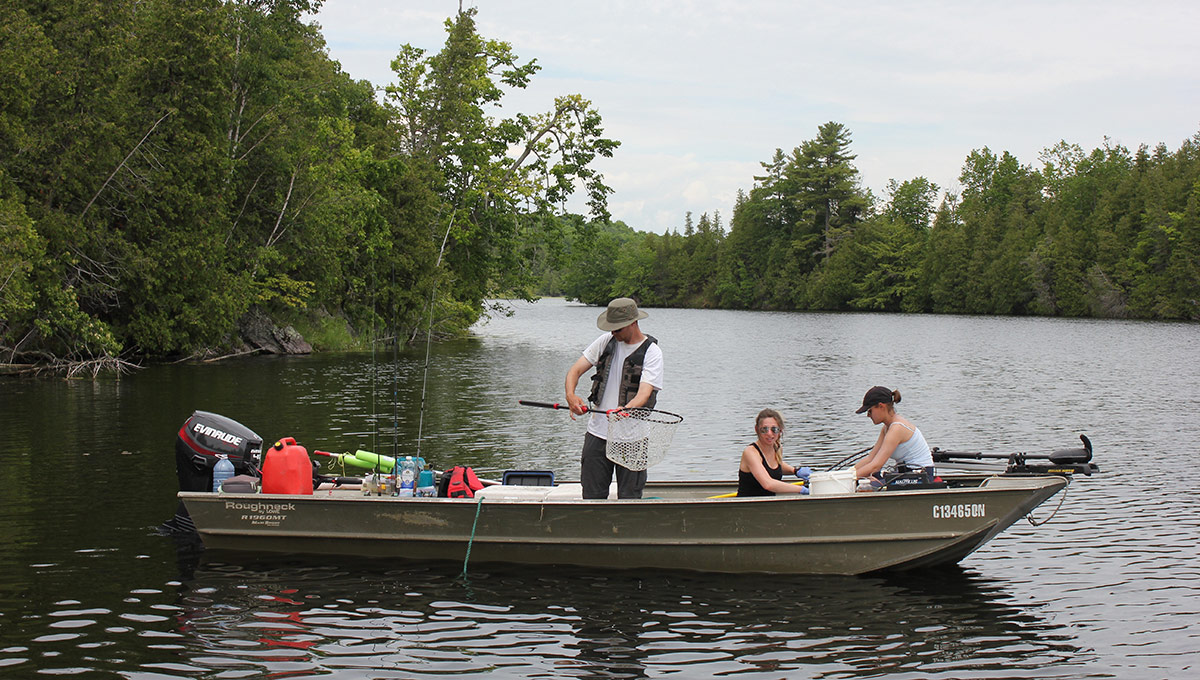
A Potential Climate Change Adaptation
There are also myriad additional side projects within the larger study, such as looking at the impact of different types of lighting at lock stations and various methods of shoreline modification, from riprap to retaining walls, and attempting to understand the long-term impacts of fish sanctuaries, eight of which are scattered around this part of the Rideau.
Fish in protected waters tend to be bolder and more exploratory than others, because aggressive fish in parts of the system that are open to angling are easier to catch, explains Cooke, which removes those particular genes from the species. But the bolder fish, with higher metabolic rates, are also more resilient — an adaptation that could help them deal with climate change.
Bergman’s research involves tagging fish caught both inside and outside sanctuaries and comparing how and when and where they move. She’s also putting tagged fish inside a lock, including fish caught both upstream and downstream from the structure, to find out which direction they move and how quickly they leave the lock when the gates are opened.
Overall, says Cooke, the project “provides opportunities for students to connect what they learn in the classroom to real issues that matter in the real world. It helps them understand how the pieces come together.
“Problems are complex, especially environmental problems,” he says, “and there are a lot of different layers. Learning how to engage with different groups — from the representatives of local lake associations to Parks Canada water level planners and Ministry of Natural Resources and Forestry conservation officers — is critically important. There’s a bit of a social license associated with what we do. If people don’t like it, they will complain.”
For Cooke, spending the day outside is a big part of the draw to this type of work, but more so, “the opportunity to interact with the next generation of scientists and people who want to learn about fish — hopefully some of my passion rubs off on them.
“We’re fortunate in our lab to have everyone from undergraduates to post-docs. If it’s somebody’s project, they’re in charge. If they’re responsible for the field crew that day, it doesn’t matter what degrees they have: there’s an opportunity for everybody to step up and lead and share and provide input.”
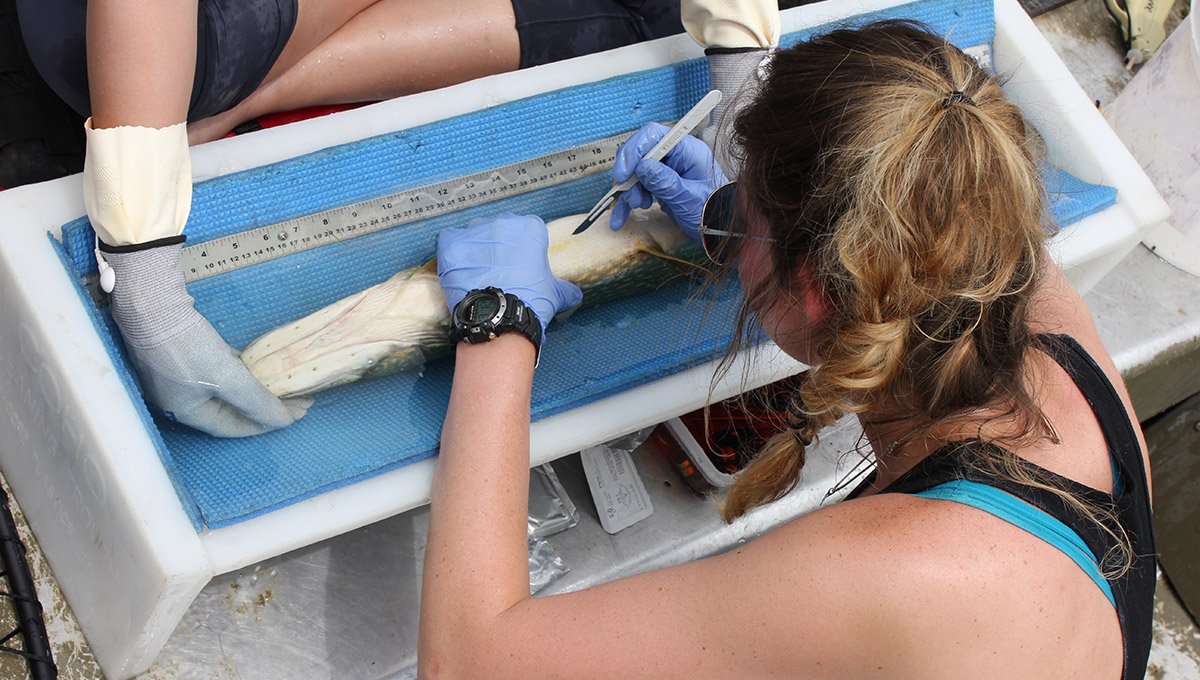
Summer Research Internship Pays Off
Standing near the bow of the boat, Brenna Gagliardi casts her hook a few dozen feet with the flick of a wrist and begins to reel in her line.
The goal today for both crews is to land 15 pike for acoustic tagging, with any bass they happen to catch getting external tags. But because pike, like most fish, are crepuscular, or more active at dawn and dusk, the steady rate of bites earlier this morning has slowed to a trickle by noon.
“It’s called fishing, not catching,” quips Bergman. “Imagine doing this all day and getting only one fish. That breaks your heart.”
In the other boat, Cooke — who dreamed when he was a child of someday hosting a television fishing show— is the only “professional” angler, Bennett jokes, astounded by his colleague’s success. Bennett, meanwhile, celebrates his few catches and talks lovingly to all of fish brought on board, a habit that Cooke teases him about.
Gagliardi, who has completed one year of her undergraduate Biology program, had never fished before this summer. She had never, in fact, seen a live fish larger than a minnow.
But then she was selected as the recipient of a Dean’s Summer Research Internship and, after moving to a rented house in Smiths Falls for a 12-week paid position working with Bergman and Killeen, she quickly learned how to catch and identify different species, and how to assist Bergman in the on-board surgeries.
“Basically, my job is to do whatever Jordanna needs me to do,” Gagliardi says while removing some weeds from her hook for another cast.
“I never knew I would become this interested in fish. This project has sparked my curiosity about the animals that live around us. A lot of people are interested in large animals, but the ones we see frequently can be just as important.
“I’m also learning a lot about the scientific process in general: how projects come to together, how they get funded, how graduate school works. We do labs in class, but they don’t give you the big picture. And I’m making great connections with professors and grad students.”
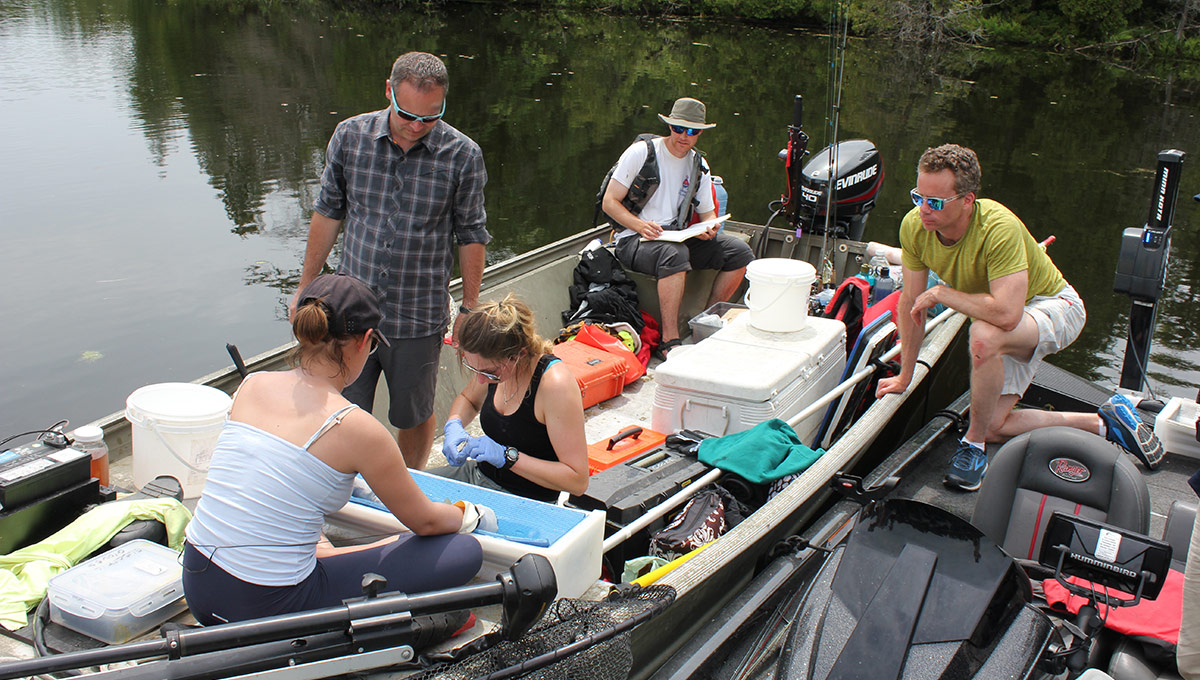
Seeing How Concepts Work in the Real World
Killeen, who has to complete a couple more courses to earn a Bachelor of Environmental Science, minoring in geomatics (which is defined as the collection and presentation of geographic data), is on the Rideau thanks to a four-month research assistant position.
Already considering job offers from organizations such as Fisheries and Oceans Canada and the Canadian Environmental Assessment Agency, he’s planning to work for a while before thinking about graduate school.
Although he grew up camping and fishing with his family, Killeen is improving his boating and angling skills this summer, which could be helpful on the job front. He’s also gaining a deeper appreciation for how the data generated in research projects like this can be applied in a geomatics context.
“When we’re putting receivers in place and tagging fish, I’m thinking about how the data will be represented in the end and what the geomatics maps will look like,” he says.
“I’ve spent four years learning a lot of these concepts in theory, but being able to go out into the field is invaluable because you get to put into practice what you learn and see how it works in real life.
“This is a much more organic way of learning — you learn things as you need to, and you remember things much more easily when you learn them on the job. Out here, as well, whether we’re talking about fish ecology or reproduction or telemetry, we’re constantly asking questions of and learning from one another.
“This sort of learning experience is almost impossible to reproduce in a classroom environment. I’ve always been interested in nature and freshwater systems, but that interest has been enhanced. A little spice has been added, a new way of looking at things.”
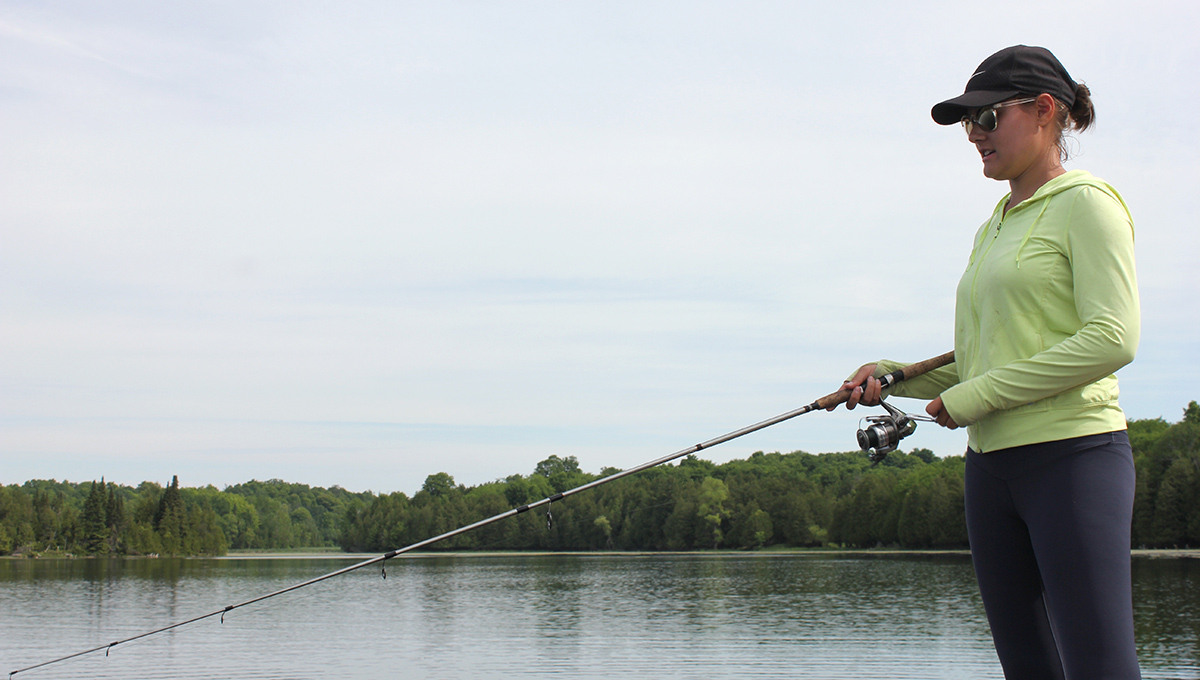
Tuesday, July 9, 2019 in Biology, Environment and Sustainability, Faculty of Science, Research
Share: Twitter, Facebook
